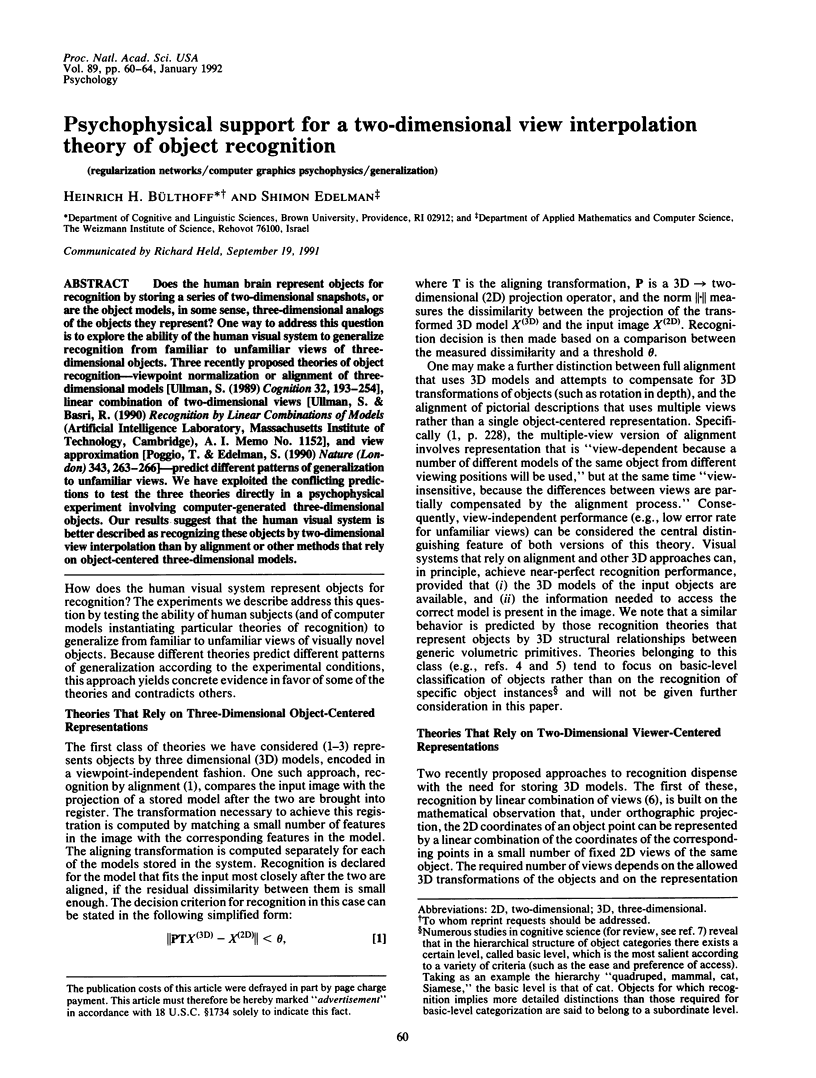Psychophysical support for a two-dimensional view interpolation theory of object recognition (original) (raw)
Abstract
Does the human brain represent objects for recognition by storing a series of two-dimensional snapshots, or are the object models, in some sense, three-dimensional analogs of the objects they represent? One way to address this question is to explore the ability of the human visual system to generalize recognition from familiar to unfamiliar views of three-dimensional objects. Three recently proposed theories of object recognition--viewpoint normalization or alignment of three-dimensional models [Ullman, S. (1989) Cognition 32, 193-254], linear combination of two-dimensional views [Ullman, S. & Basri, R. (1990) Recognition by Linear Combinations of Models (Artificial Intelligence Laboratory, Massachusetts Institute of Technology, Cambridge), A. I. Memo No. 1152], and view approximation [Poggio, T. & Edelman, S. (1990) Nature (London) 343, 263-266]--predict different patterns of generalization to unfamiliar views. We have exploited the conflicting predictions to test the three theories directly in a psychophysical experiment involving computer-generated three-dimensional objects. Our results suggest that the human visual system is better described as recognizing these objects by two-dimensional view interpolation than by alignment or other methods that rely on object-centered three-dimensional models.

Images in this article
Selected References
These references are in PubMed. This may not be the complete list of references from this article.
- Edelman S., Weinshall D. A self-organizing multiple-view representation of 3D objects. Biol Cybern. 1991;64(3):209–219. doi: 10.1007/BF00201981. [DOI] [PubMed] [Google Scholar]
- Koenderink J. J., van Doorn A. J. The internal representation of solid shape with respect to vision. Biol Cybern. 1979 May 2;32(4):211–216. doi: 10.1007/BF00337644. [DOI] [PubMed] [Google Scholar]
- Marr D., Nishihara H. K. Representation and recognition of the spatial organization of three-dimensional shapes. Proc R Soc Lond B Biol Sci. 1978 Feb 23;200(1140):269–294. doi: 10.1098/rspb.1978.0020. [DOI] [PubMed] [Google Scholar]
- Poggio T., Edelman S. A network that learns to recognize three-dimensional objects. Nature. 1990 Jan 18;343(6255):263–266. doi: 10.1038/343263a0. [DOI] [PubMed] [Google Scholar]
- Poggio T., Girosi F. Regularization algorithms for learning that are equivalent to multilayer networks. Science. 1990 Feb 23;247(4945):978–982. doi: 10.1126/science.247.4945.978. [DOI] [PubMed] [Google Scholar]
- Rock I., DiVita J. A case of viewer-centered object perception. Cogn Psychol. 1987 Apr;19(2):280–293. doi: 10.1016/0010-0285(87)90013-2. [DOI] [PubMed] [Google Scholar]
- Rock I., Wheeler D., Tudor L. Can we imagine how objects look from other viewpoints? Cogn Psychol. 1989 Apr;21(2):185–210. doi: 10.1016/0010-0285(89)90007-8. [DOI] [PubMed] [Google Scholar]
- Ullman S. Aligning pictorial descriptions: an approach to object recognition. Cognition. 1989 Aug;32(3):193–254. doi: 10.1016/0010-0277(89)90036-x. [DOI] [PubMed] [Google Scholar]